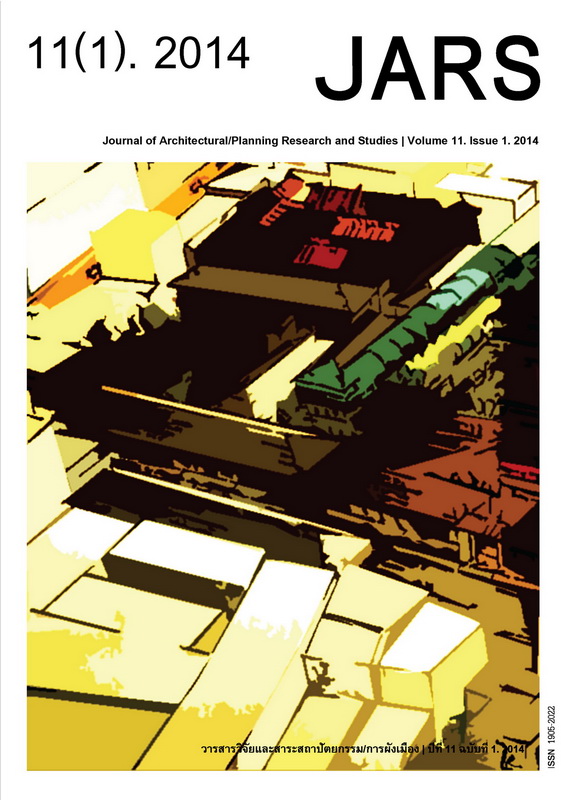Buddhism Vernacular Architecture in Songkhla Lake Basin
Main Article Content
Abstract
The evidence of the historical development of the Songkla Lake Basin (covering Nakhon Si Thammarat Province, Songkhla Province, and Pattalung Province) has been found since the 5th BE, and clearly noticed during the 12-13th BE as the port of Srivijaya Kingdom. Then in 16th BE, pieces of evidence of relationship with the Song Dynasty of China were found. During the 17-18th BE, Nakhon Si Thammarat played its role as the centre of Tambalinga Kingdom. In the 20th BE, many cities in the South were under the control of Ayudhya and Rattanakosin, the capitals, respectively. Political control and Buddhism were clearly seen. For economic circumstance, people lived their lives mainly on farming and doing agricultural activities. Due to the fact that farming needed much labour, people lived altogether. Communities expanded and temples were their centre.
For the study of the floor plan of Buddhism vernacular architecture, it was found that the compositions and forms were similar to those found in the Chao Phraya Basin during Ayudhya and Rattanakosin period because of influence and relationship in terms of politics and Buddhism. However, due to its geographical aspects, the South has witnessed and experienced other cultures. This affected forms of architecture although the South has mainly been inspired by the Central Region, along with its own transformation and evolution. The study also found that the floor plan of temples is similar to that of the Central Region, for example Ubosot and the main Chedi were the main compositions, found in old temples, while Bua or small Chedi, keeping ancestors’ relics, were found in small temples, both outdoor or in the pavilion. The pavilions for miscellaneous purposes, because of the monsoon, were also found in the floor plan. In addition, vernacular architecture for shadow puppet theatre was also found generally.
Downloads
Article Details

This work is licensed under a Creative Commons Attribution-NonCommercial-NoDerivatives 4.0 International License.
All material is licensed under the terms of the Creative Commons Attribution 4.0 International (CC-BY-NC-ND 4.0) License, unless otherwise stated. As such, authors are free to share, copy, and redistribute the material in any medium or format. The authors must give appropriate credit, provide a link to the license, and indicate if changes were made. The authors may do so in any reasonable manner, but not in any way that suggests the licensor endorses you or your use. The authors may not use the material for commercial purposes. If the authors remix, transform, or build upon the material, they may not distribute the modified material, unless permission is obtained from JARS. Final, accepted versions of the paper may be posted on third party repositories, provided appropriate acknowledgement to the original source is clearly noted.
References
Angwitthayathon, C. (2001). การแลกเปลี่ยนและการค้าข้าวบริเวณชุมชนรอบทะเลสาบสงขลา [Exchange and rice trading in villages around Songkla Lake]. Bangkok, Thailand: The Thailand Research Fund (TRF).
Butsararat, P. (1992). โนราโรงครูวัดท่าแค อ.เมือง จ.พัทลุง [Nora Rong Kru: Traditional southern performing art at Wat Ta Kae, muang district, Pattalung]. Master of Arts Thesis, Srinakharinwirot University (Songkhla Campus), Songkhla, Thailand.
Butsararat, P. (2010). นาฏกรรมแห่งลุ่มทะเลสาบสงขลา การเปลี่ยนแปลงและความสัมพันธ์กับสังคมและวัฒนธรรมของหนังตะลุงและโนรา [Traditional show of Songkla Lake basin: Relationship between socio-cultural aspects of shadow puppet and traditional southern performing art and its changes]. Bangkok, Thailand: The Thailand Research Fund (TRF).
Chumpengpan, P. (2005). ศิลปวัฒนธรรมภาคใต้ [Art and culture in Southern of Thailand]. Bangkok, Thailand: Suweriyasarn Publishing.
Chuwaen, Y. (1998). โลกของลุ่มทะเลสาบรวมบทความว่าด้วยประวัติศาสตร์และวัฒนธรรมท้องถิ่นลุ่มทะเลสาบสงขลา [Contributed articles on social life and customs of communities in Songkhla Lake region, Songkhla province, Thailand.]. Phranakhon, Bangkok, Thailand: Nakorn Publishing.
Jiratatsanakul, S. (2002). วัด: พุทธศาสนสถาปัตยกรรมไทย [Wat: Thai Buddhist architectural monastery]. Bangkok, Thailand: Thammasat Printing House.
Pengkaew, N. (2001). เรื่องเล่าจากสทิงพระ [Tales form Sating Pra]. In รอยทางแห่งเวลา [Tracing of time]. Bangkok, Thailand: Praew Publishing.
Pigafetta, A. (1874). The first voyage round the world, by Magellan (The accounts of pigafetta and other contemporary writers, Trans.). London: The Hakluyt Society.
Phongphaibun, S. (2001). ภูมิปัญญาภาคใต้[Local wisdom in Southern of Thailand]. Bangkok, Thailand: Amarin Printing & Publishing Public Company Limited.
Pongsripian, W. (2011a). จารึกพระเจ้ากรุงศรีวิชัย และจารึกศรีมหาราช [Inscription of Srivijaya’s King and inscription of Sri Maharaja]. In 100 เอกสารสําคัญ: สรรพสาระประวัติศาสตร์ไทย ลำดับที่ 10 10 [100 Keys documents in Thai history No. 10]. Bangkok, Thailand: The Thailand Research Fund (TRF).
Pongsripian, W. (2011b). จารึกพระเจ้าจันทรภานุ ศรีธรรมราชา: มรดกความทรงจําแห่งนครศรีธรรมราช [Chandara Bhanu Sri Dhamraja’s inscription: Historical documents of Nakhon Si Thammarat]. In 100 เอกสารสําคัญ: สรรพสาระประวัติศาสตร์ไทย ลําดับที่ 10 10 [100 Keys documents in Thai history No. 10]. Bangkok, Thailand: The Thailand Research Fund (TRF).
Pongsripian, W. (2011c). นครศรีธรรมราชในจดหมายแฟร์นาว เมนเดส ปินตูค.ศ.1543 และปัตตานีและนครศรีธรรมราชในสารานุกรมฝรั่งเศส ค.ศ. 1660 [Nakhon Si Thammarat in Fernão Mendez Pinto’ document and Pattani and Nakhon Si Thammarat in French encyclopedia, 1660]. In 100 เอกสารสําคัญ: สรรพสาระประวัติศาสตร์ไทย ลำดับที่ 12 [100 Keys documents in Thai history No. 12]. Bangkok: The Thailand Research Fund (TRF).
Pongsripian, W. (2011d). พระตําราเพื่อกัลปนา (1): มรดกความทรงจําแห่งเมืองพัทลุง [Phra Tamra Pue Kanlapana: the historical docum ent of Pattalung]. In 100 เอกสารสําคัญ: สรรพสาระประวัติศาสตร์ไทย ลําดับที่ 12 [100 Keys Documents in Thai History No. 12]. Bangkok, Thailand: The Thailand Research Fund (TRF).
Tanthai, K. (2009). หนึ่งศตวรรษเศรษฐกิจของคนลุ่มทะเลสาบสงขลา สงขลา [1 Century of socio-economic aspects around Songkla Lake basin]. Bangkok, Thailand: The Thailand Research Fund (TRF).
Thongsai, S. (n.d.). สถานภาพและบทบาทหนังตะลุง จ.พัทลุง [The situation and role of shadow puppet in Pattalung province]. Phatthalung, Thailand: Phatthalung Cultural Office.
Fine art Department. (1962). ตํานานเมืองนครศรีธรรมราช [Chronicle of Nakhon Si Thammarat]. In รวมเรื่องเมืองนครศรีธรรมราช (พิมพ์เป็นอนุสรณ์ในงานพระราชทานเพลิงศพ พลเอก เจ้าพระยาบดินทรเดชานุชิต (แย้ม ณนคร) ณ เมรุหน้าพลับพลาอิสริยาภรณ์ วัดเทพศิรินทราวาส 27 กุมภาพันธ์ 2505) [Contributed documents in Nakhon Si Thammarat’s contexts]. Phranakhon, Thailand: Author.


